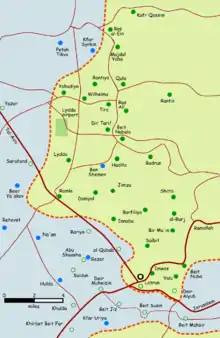Ben Shemen
Ben Shemen (Hebrew: בֶּן שֶׁמֶן, lit. very fruitful) is a moshav in central Israel. Located around four kilometres east of Lod, it falls under the jurisdiction of Hevel Modi'in Regional Council. In 2019 it had a population of 870.[1]
Ben Shemen
בֶּן שֶׁמֶן | |
|---|---|
 | |
 Ben Shemen | |
| Coordinates: 31°57′14.4″N 34°55′29.64″E | |
| Country | Israel |
| District | Central |
| Council | Hevel Modi'in |
| Affiliation | Moshavim Movement |
| Founded | 1905 (original) 1952 (re-establishment) |
| Population (2019)[1] | 870 |

Etymology
The village's name is taken from Isaiah 5:1:[2]
Let me sing of my well-beloved, a song of my beloved touching his vineyard. My well-beloved had a vineyard in a very fruitful hill.[3]
and also reflects the JNF's planting of olive trees in this area.[4]
History
The moshav was founded in 1905, and was one of the first villages established on Jewish National Fund land;[4] the first Jewish National Fund forest is also located in Ben Shemen.[4] According to a census conducted in 1922 by the British Mandate authorities, Ben Shemen had a population of 90 Jews.[5] Which had increased in the 1931 census to 353 residents, in 30 houses.[6] In 1923 it was split in two, with a group of trial farms eventually becoming a separate moshav, Kerem Ben Shemen.
The Ben Shemen Youth Village was established adjacent to the moshav in 1927 and is today a large agricultural boarding school.[7][4]
During World War II, Ben Shemen was the site of a British search for weapons. Similar searches were a common British response to Jewish opposition to the White Paper of 1939.[8] In 1947 Ben Shemen had a population of 75.[4] The village experienced extensive damage during the early days of the 1948 Arab–Israeli war and had to be reconstructed.[4] Immigrants from Romania joined the moshav in 1952. Some houses were built by Bezalel Academy of Art and Design founder Boris Schatz.
 Ben Shemen 1942 1:20,000
Ben Shemen 1942 1:20,000 Ben Shemen 1945 1:250,000
Ben Shemen 1945 1:250,000 Depopulated villages in the Ramle Subdistrict
Depopulated villages in the Ramle Subdistrict
 Ben Shemen 1927
Ben Shemen 1927 Ben Shemen 1928
Ben Shemen 1928 Ben Shemen 1948. Photograph from Palmach archive
Ben Shemen 1948. Photograph from Palmach archive Ben Shemen. 1948. Used as a base by the Yiftach Brigade
Ben Shemen. 1948. Used as a base by the Yiftach Brigade Ben Shemen 1948. Dining room
Ben Shemen 1948. Dining room Ben Shemen. Harvest
Ben Shemen. Harvest Ben Shemen. Processing wool
Ben Shemen. Processing wool Ben Shemen being evacuated in early 1948
Ben Shemen being evacuated in early 1948
Notable residents
See also
References
- "Population in the Localities 2019" (XLS). Israel Central Bureau of Statistics. Retrieved 16 August 2020.
- Vilnay, Zev, Rachel and Oren: The Vilnay Guide to Israel. A new Millenium edition, Vol 1: Jerusalem, Beersheba and Southern Israel, Atlit 1999, p. 212, ISBN 965-90269-0-0
- Isaiah Chapter 5 Mechon Mamre
- Jewish National Fund (1949). Jewish Villages in Israel. Jerusalem: Hamadpis Liphshitz Press. p. 16.
- Mills, 1932, p. 19
- Roth, Chaya H. (September 16, 2008). The fate of Holocaust memories: transmission and family dialogues. New York, NY: Palgrave Macmillan. p. 83.
- Anita, Shapira (1992). Land and Power, The Zionist Resort to Force. Oxford: Oxford University Press. p. 288.
External links
- Ben Shemen, Cross-Israel Highway: Reproduction of an oil press Israel Antiquities Authority